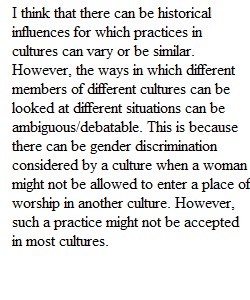


Q Cultural intersection can highlight the issue of mutual benefits (how cultures benefit from other cultures) as well as raise questions about cultural survival or resilience -- how a culture survives hegemony or preserves (aspects of) its particularity. An aspect of that resilience is the ability to deal with external influences or inclusively adapt to a changing world. What colonialism or the “civilizing” missions that Mignolo references did in some other parts of the world, for instance, was to impose foreign civilizations on cultures that were deemed uncivilized. In the process, some cultures (or cultural practices) disappeared. But many survived because they adopted or adapted these foreign cultures for practical reasons (and not necessarily because the structure of their thought fundamentally or forever changed). In an essay, “Identity and Minority: Value Conflicts and Conflicts of Identity,” Harold Ofstad makes the point that a “group normally guards its norm- and value myths more zealously than the norms and values it actually lives by. It is therefore relatively easy to accept changes in practice, given that they do not too obviously conflict with the myths.” These norm- and value myths, according to Ofstad, help ensure the continuity of culture (or tradition). Even when people adapt or change their lifestyles because of various reasons (including globalization), the persistence of their belief systems can point to degrees of cultural survival. This is one of the reasons why myths (usually rooted in cultural particulars) are significant -- because they are often framed around a society’s core values and represent not mere flights of fancy but routes through which cultural-ideological meanings become either ingrained or resist outside pressures. New myths sprout in response to new situations – not arbitrarily, but according to conventions derived from old myths, which trace a path back to traditional values and perceptions.
View Related Questions